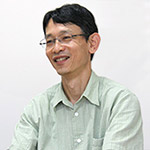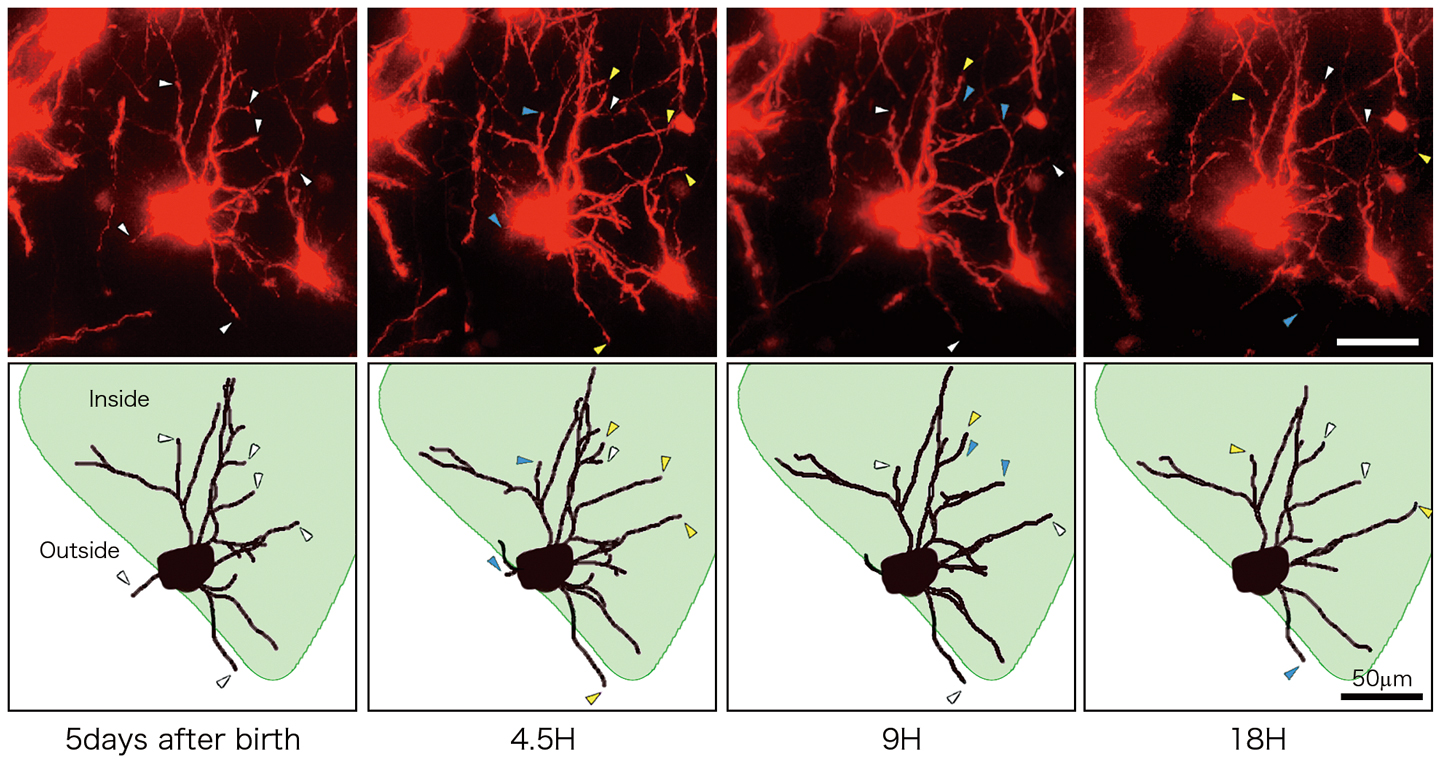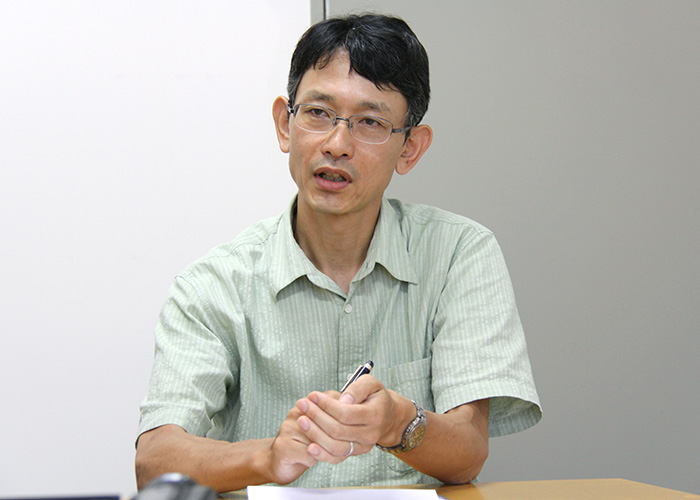Professor IWASATO, Takuji

After graduating from the Faculty of Science, Kyoto University, Dr. Iwasato received a Doctor of Science degree from the Graduate School of Science, Kyoto University. He worked as a special research fellow of the Japan Society for the Promotion of Science, as a postdoctoral fellow in the Tonegawa Laboratory at the Massachusetts Institute of Technology, and as a center researcher and vice team leader at the RIKEN Brain Science Institute. In 2008, he was appointed as a Professor at the National Institute of Genetics.
“Seeing”brain development using mouse genetics and by developing imaging technology
Immediately after birth, a mouse brain undergoes changes to form proper neural circuits, while receiving external stimuli. Dr. Iwasato successfully “sees”the process of development by developing a technique that utilizes genetic engineering technology. Using the mouse system, he tries to reveal how the cerebral cortex develops in newborns to form neural circuits that enable advanced information processing.
Neuron dendrites undergo dynamic extension and retraction
As mice are nocturnal, sensitive whiskers are as important to them as eyesight is to humans. Barrels are morphological structures composed of neurons located in the cerebral cortex layer 4, and they process the input from whiskers. Interestingly, as each barrel corresponds with a single whisker, mice can distinguish sensations from each individual whisker. Neural circuits of barrels are formed, while input is received from whiskers after birth; this raises the question, what is happening in the brain during this process? Dr. Iwasato has conducted research to develop a new technique that enables in vivo observation of neural circuits in the brain of neonatal mice.
“One of the techniques that we have developed is the sparse labeling of neurons. As neurons are densely distributed, if they are all labeled, we cannot capture the shape of each cell. For this reason, we devised a method that sparsely labels neurons so that only the targeted neurons can be clearly seen. We have also developed a mouse line whose information path (axons) from its whiskers is visible. By labeling the input axons (axons that transfer the input from whiskers) in green, and receiving neurons (neurons in the cerebral cortex that receive the input) in red, you can visualize their interactions.”
Newborn mice that underwent such genetic manipulation were observed at specific time intervals using 2-photon microscope.
Dr. Iwasato explains, “Dendrites of neurons showed extension and retraction both inside of barrels, where it receives input from whiskers, and outside of barrels, where no input occurs, and they eventually expanded inward during the process. When neurons are prepared by genetic engineering without the ability to recognize inputs correctly, the dendrites demonstrate more dynamic movement and expand toward both inside and outside of the barrels.”
“I think that neuron dendrites in the cerebral cortex of a newborn are searching for a partner,
a partner who transfers sensational input, to generate a circuit. They may keep looking for a partner when they meet the correct one but cannot recognize it. This discovery itself is exciting, but if we further improve the level of technology, we should be able to observe many phenomena that no one in the world has ever seen, he continued.
“I am interested in the development of the human brain. To visualize brain development and interpret it in molecular levels, we use the mouse brain and develop new methods.”

Normal maturation of cerebral cortex neurons in a neonatal mouse observed with a 2-photon microscope. Arrowhead: position of the dendrite tip. Yellow arrowhead: extended branch. Blue arrowhead: retracted branch. Areas shown in green at the bottom of the figure indicate the inside of barrels.
Being exposed to the essence of research in the Tonegawa Laboratory
In the graduate program, Dr. Iwasato joined the Molecular Biology Laboratory because he was attracted to the genetic mechanisms that he had learnt about during undergraduate study. There he studied Molecular Immunology. After obtaining his PhD and meeting the Nobel award winner Dr. Susumu Tonegawa, he decided to change his research field from Immunology to Neuroscience.
He says, “While studying immunology in the graduate program, I read a lot of articles written by Dr. Tonegawa’s group. After winning the Nobel Prize, Dr. Tonegawa switched his research field from immunology to neuroscience and began researches on the memory using gene knockout mouse. I was extremely excited, as I realized something completely new can be done that connects genes and human thought. That is why I decided to work as a postdoctoral fellow in the Tonegawa Laboratory.”
“However, soon after I arrived in the US, I realized that I knew little about neuroscience, I did not know how to handle mice, and could not even speak English. I felt discouraged at first, but if I had decided to join the group after more preparation, nothing would have happened forever. After jumping in and working hard, I was able to write a paper in 5 years, which gave me huge confidence. Then I decided to continue as a researcher. I was in my mid-30s at that time.”
“I respect Dr. Tonegawa. Even after achieving fame, he tackles science seriously. Looking at him, I realized that research is an occupation worth pursuing for the rest of my life.”
No one can teach how to conduct research
Currently, three graduate students work at Dr. Iwasato’s laboratory. “I would like to build a place where the hidden talents of young people are discovered.”
“I believe that graduate school is not a place where something is taught, but a place where you learn on your own and gain the ability to be independent. No one can be taught how to conduct research because research is all about doing something that no one has ever done. To establish one’s own style, one has to repeatedly carry out the process of trial and error, listen to others, and take responsibility. You may feel lost at first, but once you make up your mind and take the initiative instead of waiting around, things become much more exciting. I believe that all I need to do is to provide students with a good environment and opportunity.”
He says, when he talks to students or young researchers as a supervisor, he tries not to use vague words.
“Dr. Tonegawa was a person who strictly examined each word in manuscripts. As I was grasping things more roughly at that time, I was unable to provide sufficient answers when he asked me about the correctness of the words.”
“When you learn about other people’s work, if you vaguely read their articles, you can only know ‘what has been revealed,’ but what you need to know is ‘what is unknown.’ You will see what is unknown when you read the papers more strictly. It may remain unknown because a technique required is not yet available. Alternatively, it may be something you have missed. Therefore, it is important to use every word carefully.
I wish to write a paper that will be a classical work

Dr. Iwasato says, “Ideally, I wish to conduct research that becomes a classic research.
I would like to develop knowledge that last for a long time and is stable enough for extensive research to be built upon it.”
“In addition, I believe that science is basically entertainment. It would be best if your research makes people excited.”
When he was asked, “What do you enjoy in your research?”he answered “We can create our own artworks = articles.”
“I think scientific research resembles film production. You can create your own work using various facilities and collaborating with many people. It is an exciting and blessed work. I do not think that a professor is the director; instead I think that individual researchers are all directors. Publications are not just for achievements for grant applications; I enjoy writing papers. We can include all our philosophy in it. Ideally, the article with which you are completely satisfied excites other people and is also useful for the society. I am not there yet,”says Dr. Iwasato, laughing as he says this.
“One of my favorite film directors is Akira Kurosawa. The scale of his film is huge, but the details are also well thought out. His films are for entertainment but not merely frivolous because they have concrete philosophy. I also like James Cameron. He developed a camera just to film Avatar. If it is not available, make it yourself; this is how I aspire to conduct my research.”
(Text translated based on the interview conducted by Yoshiko Tamura in August 2014)















